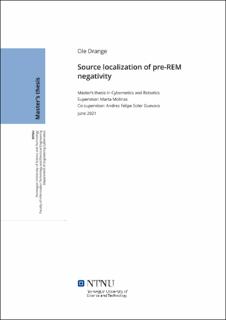| dc.contributor.advisor | Molinas, Marta | |
| dc.contributor.advisor | Soler Guevara, Andres Felipe | |
| dc.contributor.author | Drange, Ole | |
| dc.date.accessioned | 2021-10-05T17:37:34Z | |
| dc.date.available | 2021-10-05T17:37:34Z | |
| dc.date.issued | 2021 | |
| dc.identifier | no.ntnu:inspera:76427839:46960976 | |
| dc.identifier.uri | https://hdl.handle.net/11250/2787891 | |
| dc.description.abstract | Raske øyebevegelser (REM) under søvn er en beskrivelse av REM-søvnstadiet, det er velkjent at REM-søvn spiller en viktig rolle i søvn. Derfor å finne nøyaktig hjerne aktivering før REM kan bidra til å belyse hjerneområdene som er involvert for å produsere denne viktige hendelsen. Denne studien tar sikte på å finne hjerne aktivering i før REM aktiviteten. For å gjøre det er det nødvendig å finne start tiden for øyebevegelsene. En algoritme for å oppdage øyets bevegelsesutbrudd ble først utviklet og evaluert i søvn- og våkne data, deretter ble hjerne aktivering av før REM aktiviteten funnet. Etterpå ble en T-test implementert for å finne betydelig aktivering under før REM aktiviteten. Datasettet som ble brukt i studien ble registrert av Human Sleep Lab fra International Institute of Integrative Sleep Medicine og ble analysert ved hjelp av MNE åpen kildekode-python-pakke. Algoritmen er en forbedret metode basert på en tidligere laget øyebevegelsesalgoritme av Takahashi i 1997. Resultatene viste at algoritmen hadde en tilbakekalling på 0,97, en presisjon på 0,69 og en F1-score på 0,80. I tillegg ble den nye algoritmen testet for å kategorisere REM-søvnstadiet, hvor denne tilnærmingen ble funnet å identifisere REM-søvn i hele nattesøvnen. For å lokalisere før REM aktiviteten ble to metoder for hjerne aktivering implementert, og områdene med betydelig aktivering i før REM aktiviteten ble identifisert. Resultatene antyder at før REM aktiviteten har den viktigste aktiviseringen i striatum og de orbitofrontale regionene.
Disse resultatene viser at algoritmen kan finne øyebevegelser i REM søvn og finne REM søvn stadiet. Imidlertid er forbedring av algoritmen nødvendig før algoritmens resultat kan stole på uten visuell inspeksjon av resultatene. Hjerne aktivering i striatum og orbitofrontal regioner indikerer hjernens bruk av belønning eller straff, og en beslutningsprosess i hjernen er aktiv. For videre forskning anbefales det å se på algoritmekriteriene og øke algoritmens presisjon. Før REM aktiveringen i REM søvn bør også undersøkes nærmere for å finne flere forbindelser til hjernesykdommer. | |
| dc.description.abstract | Rapid eye movements (REM) during sleep is a descriptor of the REM sleep stage, it is well known that REM sleep plays an essential role in sleep. Therefore, precisely locate the source activity before the REM can help elucidate the brain areas involved to produce this important event. This study aims to find the source activation in the pre-REM negativity. To do so, the onsets of the eye movement were required. An algorithm to detect the eye movement onsets was firstly developed and evaluated in sleep and awake data, then, the source reconstruction of the pre-REM activity was found. Afterward, a T-test was implemented to find significant activation during pre-REM negativity. The dataset used in the study was registered by the Human Sleep Lab of the International Institute of Integrative Sleep Medicine and was analyzed using the MNE open-source python package. The algorithm is an improved method based on a previously made eye movement algorithm by Takahashi in 1997. The results showed that the algorithm had a recall of 0.97, a precision of 0.69, and an F1 score of 0.80. Additionally, the new algorithm was tested for categorizing the REM sleep stage, where this approach was found to identify REM sleep in whole night recordings. To localize the pre-REM negativity, two methods of source reconstruction were implemented and the areas with significant activation in the pre-REM negativity were identified. The results suggest that the pre-REM negativity has the most significant activation in the striatum and the orbitofrontal regions.
These results show that the algorithm can find eye movements in REM sleep and find the REM sleeping stage. However, improvement of the algorithm is needed before the algorithm's output can be trusted without a visual inspection of the results. Source activation in the striatum and orbitofrontal regions indicates the brain's use of a reward or punishment, and a decision-making process of the brain is active. For further research, looking at the algorithm criteria and increasing the algorithm's precision is recommended. The Pre-REM negativity's effect in REM sleep should also be researched further to find more connections to brain disorders. | |
| dc.language | eng | |
| dc.publisher | NTNU | |
| dc.title | Source localization of pre-REM negativity | |
| dc.type | Master thesis | |
